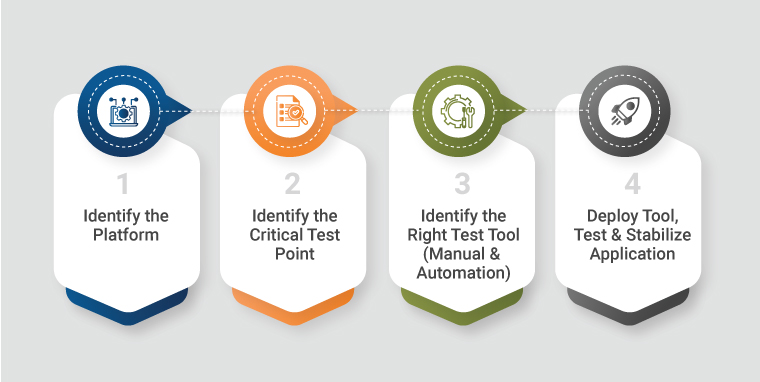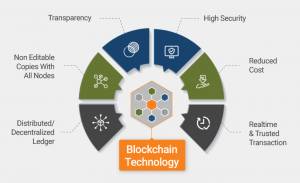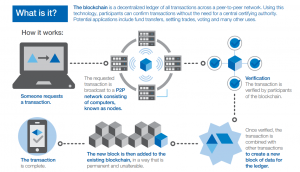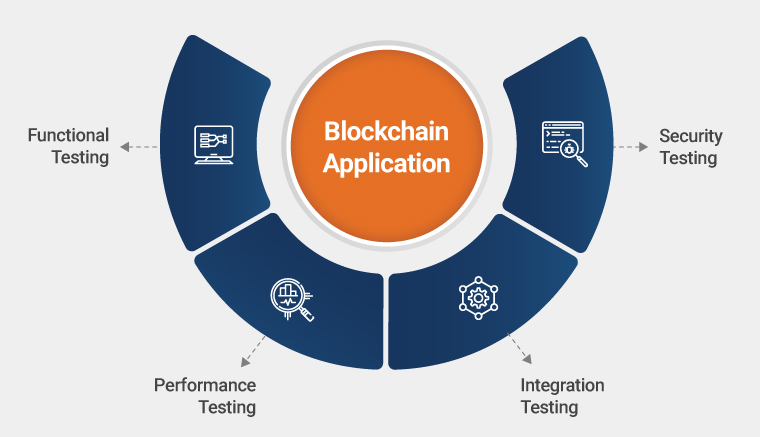A successful company’s goal is to safely store digital data and operate it on a trusted platform, and companies worldwide are shifting to blockchain data storage. A blockchain organizes data into blocks and encrypts them, increasing data security.
Blockchain has been the industry buzzword since 2009 when Satoshi Nakamoto implemented blockchain technology as a core component of Bitcoin; the industry buzzword has been blockchain. The success of Bitcoin demonstrated the capabilities of blockchain-based transactions, and now everyone is planning to incorporate blockchain technology into almost everything.
In this blog, we’ll discuss what blockchain testing is about, its types, what phases and tools can be used, and how blockchain is revolutionizing in the future. We’ll also build and test a smart contract with some of the recommended testing tools.
Blockchain: What is it?
The term “blockchain” refers to a digital ledger in which records are bound together in small blocks to form a continuous chain, hence the name. This digital ledger has distinct characteristics that set it apart. For example, it is decentralized, meaning that each transaction added to the chain is replicating so that each node has the same copy.
Secondly, once a record is added to the chain, it cannot be edited or recalled. While these distinctive features distinguish this ledger, they also complicate it. As a result, proper testing and validation need to perform before deploying a blockchain.
Why Blockchain Technology?
Assume a person checks into a hotel, and the hotel blocks their credit card for the amount of their entire stay, and the current block on the credit card can only be detached after check-out. Is it necessary? Yes, since there is a lack of trust between the client and the company.
This can be remedied utilizing blockchain technology, and there is no need to block the money unnecessarily.
Similarly, an import and export firm does not need to execute SWIFT transactions since the bank guarantees the items until they reach the importer, thus benefiting companies with tamper-proof, safe, and transparent transactions. This is accomplished by utilizing Blockchains’ peer-to-peer ledgers, encrypting transactions, and providing real-time payments.
According to a World Economic Forum report, blockchain-based technology may be used to store 10% of global GDP by 2027. Isn’t it interesting? With this data, blockchain technology may be viewed as the future, and every organization should consider if it can be used to help them expand. A blockchain is a highly secure and encrypted digital record that takes the form of a chain of blocks connected using encryption.
This cryptography employs a hashing function, which is the act of generating a unique key value after entering a value into the hash function. To stay linked, each block in the blockchain will have a unique hash value, and each block will have the hash value of the preceding block. Blockchain technology was initially created for digital currencies like Bitcoin, but its merits led to its use in documenting financial transactions and essentially everything of substantial value.
Where is blockchain used, and how?
Due to its safe nature of business, the commercial and automotive sectors use blockchain mostly. Bitcoin and Ethereum, for example, get effective support from this technology. The graphic below shows how blockchain technology transactions function.
Source: weforum
What exactly does blockchain testing entail?
“Blockchain testing” is the process of systematically evaluating the blockchain’s many functional components (e.g., smart contracts). Unlike traditional software testing, blockchain testing involves a number of components such as blocks, mining, transactions, wallets, and so on, all of which necessitate the use of specialized testing tools.
Moreover, blockchain testing contributes to developing various quality stages, ranging from system performance to blockchain application security. Blockchain was originally intended to be a secure online platform for transferring and processing cryptocurrency.
Some of its current applications include sorting transactions for a faster or more affordable payment method, encrypting patient digital health information for increased privacy, and more.
Why is blockchain testing so important?
Blockchain technology has transformed the way businesses operate. It is at the heart of popular digital currencies like Bitcoin. Testers must learn how to assess blockchain applications with expanding deployment and integration capabilities.
Where are they most likely to run into trouble? Furthermore, blockchain uses are not inadequate to the financial realm; its smart contract base is built into a wide range of fields, from energy allocation to government functions. All of those mentioned above provide distinct obstacles to blockchain debugging.
In addition, with blockchain technologies’ growing popularity, we must be willing to modify existing testing methodologies. However, some of the primary testing issues in the blockchain include a lack of best practices and the provision of appropriate means for dealing with the size, test data, security, and performance.
Testing a blockchain network guarantees that all key stakeholders are appropriately validated for operation. As a result, it provides a secure and functioning infrastructure for businesses.
- Ensures that a decentralized ledger is free of flaws.
- Aids in the validation of all entities in which the system takes part.
- Ensures that the blockchain ecosystem has matured and is functioning as intended.
- Allows companies to design and deploy blockchain technology safely.
- Reduces the risk of introducing new apps while also facilitating a smooth revalidation.
The Current QA Approach to Blockchain Technology-An Overview
Testing Blockchain-based apps present many issues as a result of technological advancements. We require specialist competencies such as Smart Contract Testing, Node/Peer Testing, and mathematical and cryptographic talent.
We have industry-leading technologies in addition to standard testing and validation, such as integration testing, functional and non-functional testing, security testing, and performance testing.
Checks and Confirmation in Blockchain Testing
A blockchain confines to a modular network of nodes, with the nodes being high-performance computer systems. Every node in the universal network copies the blockchain’s transaction history, and the blockchain verification process is dependent on consensus procedures.
While confirming a recent transaction and building a new block for it, all nodes need data input that they cross-check against available data.
Due to the nature of the blockchain system and all of the distinct entities it requires to operate, such as massive nodes — there are multiple encryption algorithms for communication between nodes exchanging transactional data.
Validating all these different entities is necessary to verify that the established blockchain ecosystem works as intended.
Blockchain testing types
Functional Testing:
Functional testing is critical in evaluating the business circumstances and the success of use-case scenarios. The following are the major concerns for doing functional testing in blockchain applications:
-
Block Size:
Each block in a blockchain has a memory capacity of megabytes, cut from 36MB to 1 MB for security reasons.
Testing must consider scenarios such as what encryption mechanism must be executed when each block’s transaction data record reaches 1MB, or other challenging scenarios.
-
Data Transfer:
Data loss during block transmission requires checking, as the core design of blockchain centers around data transactions and security.
-
Smart Contract:
Ensuring that the parties participating in transactions follow the smart contract terms will guarantee that the blockchain application runs smoothly.
-
Node Testing:
For a smooth network operation, it is necessary to check all the nodes individually.
Integration testing:
It is necessary since blockchain is an ecosystem consisting of various components. It is also critical that the different APIs connected to these components need to validate for compatibility with one another.
Performance Testing:
It is essential to test the performance of a blockchain when hundreds or thousands of transactions or large transaction sizes are under consideration for a block or an application about to go into production.
The network, the sequence of transactions at each node, transaction processing speed, user and system interface, and the replies required from smart contracts, are all critical and dependent aspects.
Security Testing:
It is essential to thoroughly test blockchain apps to ensure they are secure and reliable and to check whether the authentication and permission functions are reliable. Moreover, security testing includes other vital factors like confidentiality, non-denial of service, and integrity.
In the case of a hack of the blockchain application’s identity layer, security testing becomes imperative. Existing transactions cannot be quickly concluded if an identity layer attack occurs. As a result, security analysis becomes necessary to uncover all possible identity layer attacks.
The Different Phases of Blockchain Testing
Here are the phases of blockchain testing.
Initiation Phase:
Understanding Blockchain Architecture:
We examine and comprehend the business and functional needs in this step. This outlines the application’s behavior and how the visitor will engage with it.
The Full Strategy for the Test Design:
During this step, we’ll go through how to test an application. This is performed in great detail to accomplish all objectives securely.
Design Phase:
Test case creation:
During this stage, the QA team creates test cases with detailed instructions. Then, business Analysts (BA) evaluate these test cases.
Test Data Creation:
During this step, test data is prepared or retrieved from the prior environment to ensure compliance with business requirements. Test data is getting through manually or with the help of automated technologies.
Environment Setup:
This stage configures the testing environment to meet the application’s or business’s needs.
Performance Metrics:
Performance metrics tell us information about an application’s, system’s, or component’s performance.
Testing Phase:
API Testing:
API testing ensures that the interaction among blockchain ecosystem apps is as intended.
Block Testing:
To guarantee appropriate collaboration, each block in the system must be tested separately.
Functional Testing:
We analyze the efforts of various functional aspects of the blockchain block in functional testing (e.g., smart contracts).
Performance Evaluation:
Details such as network latency depend on block size, estimated transaction size, and how long it takes a query using the specific authentication protocol to provide the result.
Security Testing:
This ensures that the system is sensitive to assaults and that the systems can safeguard data and handle malicious attacks, among other things.
Integration Testing:
During integration testing, we ensure that all of the application’s components are working together effectively and that the activities are being carried out correctly.
Smart Contract Testing:
It is undertaking extensive functional testing of business logic and processes.
Report Phase:
Project Summary Report: Describe the general overview of project specifics, project dates, budget, and task details. This test report goes through the specifics of how smart contracts, data, and regulations are processed.
Security Testing Report:
A formal document presents vulnerable information to the client and upper management. The date of testing and an overview of the vulnerabilities discovered are all included in the report.
Performance Testing Report:
This study includes information on apps’ speed, scalability, and dependability.
Methodology for QA Recommended
Selecting the appropriate testing tool for blockchain systems is a critical step in ensuring that testing is effective and successful.

The tools listed below allow us to test blockchain apps and ensure they are working correctly.
Ethereum Tester:-
Ethereum is one of the most popular platforms for developing blockchain apps, and it comes with a slew of tools for both development and testing. Smart Contracts, API, Web3 Integration, Backend, and a variety of additional blockchain tests are all supported by Ethereum Tester. In addition, testnets mimic blockchain production (the place where real tokens and ether exist). This aids both developers and testers in simulated scenarios.
Brownie:-
The Ethereum testing capability is incorporated into this framework as a collection of capabilities enabling test contract deployment. It’s based on the pytest framework, so it’s quite simple to use.
Ganache (Testrpc):-
This tool is mainly used to test Ethereum contracts locally. It builds a blockchain simulation that allows anybody to test with different accounts. As a result, the test findings will be adequate but not perfect because they are from a virtual environment rather than an actual occurrence.
Drizzle:-
Drizzle is a part of the Truffle collection. Drizzle is a collection of front-end frameworks. It provides an essential component for building web apps that may interact with Smart Contracts smoothly.
BitcoinJ:-
It is an open-source Bitcoin client library that performs the Bitcoin protocol suite and is written in Java. It can keep track of a wallet, send and receive transactions without the need for a local database of Bitcoin Core, and has many other sophisticated capabilities.
Although it was written in Java, bitcoinj may be used with any JVM-compatible language, such as Python or JavaScript.
Embark:-
It is a blockchain app development, testing, and deployment platform. It enables the creation and distribution of decentralized apps. One or more decentralized technologies are used in a decentralized application.
Embark works with decentralized storage (IPFS), Ethereum EVM blockchains, and decentralized communication systems (Whisper and Orbit). In addition, it provides support to the deployment of Swarm.
However, following the recent incidence of a hacker stealing $31 million in ether, you may be considering outsourcing your testing requirements.
Have your internal testers overlooked any flaws in the standard smart contract code? Can you rely on your development team to test the same vital code they wrote? Are you concerned about the vulnerability of the underlying codes? You can hire testers with extensive experience in blockchain testing.
Conclusion
You should now have a better understanding of blockchain and its testing. Blockchain testing is unquestionably significant in modern civilization. Moreover, it affects the existing industry.
With the advancement of BaaS and perhaps other advancements, this is the only moment when the majority of businesses will begin to use blockchain.
So, what are your thoughts on blockchain testing? Do you see what you’re getting out of it? Please share your thoughts in the comment section below.
Image Credit: Provided by the Author; Thank you!





















